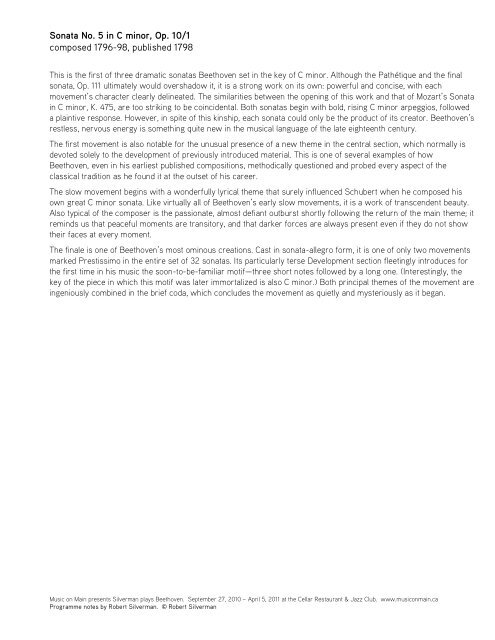beethoven's 32 piano sonatas robert silverman - Music on Main
beethoven's 32 piano sonatas robert silverman - Music on Main
beethoven's 32 piano sonatas robert silverman - Music on Main
You also want an ePaper? Increase the reach of your titles
YUMPU automatically turns print PDFs into web optimized ePapers that Google loves.
S<strong>on</strong>ata No. 5 in C minor, Op. 10/1<br />
composed 1796-98, published 1798<br />
This is the first of three dramatic <str<strong>on</strong>g>s<strong>on</strong>atas</str<strong>on</strong>g> Beethoven set in the key of C minor. Although the Pathétique and the final<br />
s<strong>on</strong>ata, Op. 111 ultimately would overshadow it, it is a str<strong>on</strong>g work <strong>on</strong> its own: powerful and c<strong>on</strong>cise, with each<br />
movement’s character clearly delineated. The similarities between the opening of this work and that of Mozart’s S<strong>on</strong>ata<br />
in C minor, K. 475, are too striking to be coincidental. Both <str<strong>on</strong>g>s<strong>on</strong>atas</str<strong>on</strong>g> begin with bold, rising C minor arpeggios, followed<br />
a plaintive resp<strong>on</strong>se. However, in spite of this kinship, each s<strong>on</strong>ata could <strong>on</strong>ly be the product of its creator. Beethoven’s<br />
restless, nervous energy is something quite new in the musical language of the late eighteenth century.<br />
The first movement is also notable for the unusual presence of a new theme in the central secti<strong>on</strong>, which normally is<br />
devoted solely to the development of previously introduced material. This is <strong>on</strong>e of several examples of how<br />
Beethoven, even in his earliest published compositi<strong>on</strong>s, methodically questi<strong>on</strong>ed and probed every aspect of the<br />
classical traditi<strong>on</strong> as he found it at the outset of his career.<br />
The slow movement begins with a w<strong>on</strong>derfully lyrical theme that surely influenced Schubert when he composed his<br />
own great C minor s<strong>on</strong>ata. Like virtually all of Beethoven’s early slow movements, it is a work of transcendent beauty.<br />
Also typical of the composer is the passi<strong>on</strong>ate, almost defiant outburst shortly following the return of the main theme; it<br />
reminds us that peaceful moments are transitory, and that darker forces are always present even if they do not show<br />
their faces at every moment.<br />
The finale is <strong>on</strong>e of Beethoven’s most ominous creati<strong>on</strong>s. Cast in s<strong>on</strong>ata-allegro form, it is <strong>on</strong>e of <strong>on</strong>ly two movements<br />
marked Prestissimo in the entire set of <str<strong>on</strong>g>32</str<strong>on</strong>g> <str<strong>on</strong>g>s<strong>on</strong>atas</str<strong>on</strong>g>. Its particularly terse Development secti<strong>on</strong> fleetingly introduces for<br />
the first time in his music the so<strong>on</strong>-to-be-familiar motif—three short notes followed by a l<strong>on</strong>g <strong>on</strong>e. (Interestingly, the<br />
key of the piece in which this motif was later immortalized is also C minor.) Both principal themes of the movement are<br />
ingeniously combined in the brief coda, which c<strong>on</strong>cludes the movement as quietly and mysteriously as it began.<br />
<str<strong>on</strong>g>Music</str<strong>on</strong>g> <strong>on</strong> <strong>Main</strong> presents Silverman plays Beethoven. September 27, 2010 – April 5, 2011 at the Cellar Restaurant & Jazz Club. www.music<strong>on</strong>main.ca<br />
Programme notes by Robert Silverman. © Robert Silverman


